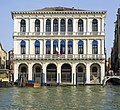Manin (noble family)
The Manin family (also Manini ) is an old family of the Italian aristocracy who came from Tuscany to Friuli and to Venice and Hungary.
history
Legend has it that the family was sometimes traced back to the ancient Gens Manlia . Historical research, however, see the progenitor with some probability in a Manno dei Bucij from Rieti in Latium, who moved via Fiesole to Florence in the 11th century , where his presumed descendants Mannini found public offices.
Shortly after 1300 the family split into three branches: the Tuscan (progenitor: Romanello ), that of Aquileia and Cividale in Friuli (progenitor: Manino II , who went to the court of the Patriarch of Aquileia in 1312 ), and the descendants by Romanello's son Giacomo II , who was initially the governor of Louis I of Hungary in Transylvania and his envoy in England from 1345–48. Giacomo II stayed at the English court and was on August 5, 1362 by Edward III. Admitted to the (lower) English nobility in recognition of his bravery in the war against France, with the special right to include the royal coat of arms in his own. The nobility was confirmed to his son Odoardo by Richard II with a diploma on September 15, 1381, but he and his son Antonio were expelled from the country in 1399 after the overthrow of the king and forced to return to Hungary. The descendants were accepted into the local nobility and are documented until shortly after 1500.
The diplomat Nicolò Manin from the Friulian branch was granted honorary citizenship of the Republic of Venice in 1385 . The Friulian family branch was active a. a. in the financial sector and cooperated with the influential Venetian families Barbaro and Dolfin . Two of the family's funerary chapels are located in Udine Cathedral . On February 4, 1526, Emperor Charles V accepted Camillo Manin into the imperial nobility with an improved coat of arms. His nephew Antonio Manin became Gastalde von Sedegliano around 1650 and acquired land in Passariano near Codroipo , where he commissioned the construction of the Villa Manin . This was completed by his grandsons Ludovico and Francesco between 1710 and 1725, when the architect Domenico Rossi added a chapel and a large exedra and had it decorated with frescoes. Antonio's son Francesco became bishop of Cittanova d'Istria .
In 1651, during the war between Venice and the Ottoman Empire over Crete, Luigi Manin bought himself membership in the patriciate of Venice for 100,000 ducats and his son Octaviano the office of procurator of San Marco (based in the procuraties ). Ludovico III. (1695–1775) was elected Podestà in Chioggia and Verona . From the early 18th century, the family lived in the Palazzo Dolfin Manin in Venice , which they bought in 1787 and had it restored. The palace remained in the possession of the Manin until 1867.
The best-known member of the family, albeit of a rather tragic reputation, was Ludovicos III. Son, Ludovico Manin (1725–1802), the 120th and last Venetian doge, who abdicated after the French occupation of Venice on May 12, 1797 and retired to the Palazzo Dolfin Manin. He had no descendants, but his brother Giovanni continued the family that received the Austrian count in the Kingdom of Lombardy-Venetia . Many family members now live in Italy ( Trieste , Friuli , Udine , Venice , Milan ) and in Croatia .
Picture gallery
Villa Manin , Passariano
Palazzo Dolfin Manin , Venice-San Marco
Ludovico Manin (1725–1802), Doge of Venice
literature
- Francesco Tomasini (ed.): Illustrious serie dell'antichissima, e Nobilissima famiglia Manini. Angelo Bontognale, Vicenza 1690 ( limited preview ).
- Giuseppe Bettinelli (Ed.): Dizionario Storico-Portatile Di Tutte Le Venete Patrizie Famiglie . Giuseppe Bettinelli, Venice 1780.
- Francesco Schröder: Repertorio Genealogico delle Famiglie confermate nobili e dei titolati nobili esistenti nelle provincie Venete. Alvisopoli, Venice 1830.
- Cristoforo Tentori: Saggio sulla Storia Civile, Politica, Ecclesiastica e sulla Corografia e Topografia degli Stati della Reppublica di Venezia. Ad uso della Nobile e Civile Gioventù. Giacomo Storti, Venice 1785.
Web links
- I Nobili Manin at enricodavenezia.it (Italian)





